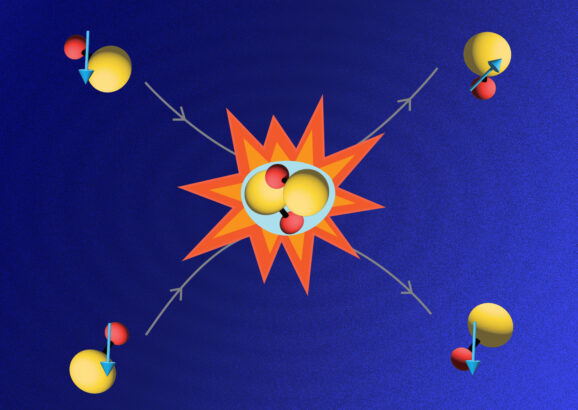Wolfgang Ketterle
2001 Nobel Laureate
Research Interests
Studies of ultracold atomic matter, superfluidity, spin physics, ultracold molecules.
Courtesy of Serious Science | YouTube
Biographical Sketch
Wolfgang Ketterle has been the John D. MacArthur Professor of Physics at MIT since 1998. He received a diploma (equivalent to master’s degree) from the Technical University of Munich (1982), and the Ph.D. in physics from the University of Munich (1986). He did postdoctoral work at the Max-Planck Institute for Quantum Optics in Garching and at the University of Heidelberg in molecular spectroscopy and combustion diagnostics. In 1990, he came to MIT as a postdoc and joined the physics faculty in 1993. Since 2006, he is the director of the Center of Ultracold Atoms, an NSF funded research center, and Associate Director of the Research Laboratory of Electronics. His research group studies properties of ultracold atomic matter.
For additional biographical information on Professor Ketterle, see his autobiography written for the Nobel Foundation.
Courtesy of Infinite MIT

Physicists observe rare resonance in molecules for the first time
The findings could provide a new way to control chemical reactions.
Awards & Honors
- 2020 // MIT Teaching With Digital Technology Award
- 2019 // Medal of the Senate of the Parliament of the Czech Republic "for excellent contributions to the development of quantum physics."
- 2016 // MIT Buechner Award for Faculty Teaching
- 2016 // Vannevar Bush Faculty Fellowship
- 2016 // American Association for the Advancement of Science Fellow (AAAS) "for his seminal contributions to achieving Bose-Einstein condensation in dilute gases of alkali atoms, and for fundamental studies of the properties of the condensates."
- 2015 // Thomson Reuters Highly Cited Researchers 2015
- 2015 // MIT School of Science teaching prize "for graduate education for his courses in Atomic and Optical Physics, 8.421 and 8.422"
- 2014 // Honorary member of the German Physics Society (DPG)
- 2014 // Honorary Professor at Northwestern Polytechnical University, Xian, China
- 2011 // Member, Russian Academy of Sciences
- 2009 // James Joyce Award of the Literary & Historical Society of University College Dublin
- 2009 // Humboldt Research Award "in recognition of lifetime achievements in research."
- 2009 // Honorary Membership, Deutscher Hochschulverband
- 2009 // James Joyce Award of the Literary & Historical Society of University College Dublin
- 2009 // Leonie Wild Medal of the Town of Eppelheim
- 2006 // Optical Society of America (OSA) Fellow
- 2005 // Honorary Degree of Doctor of Science from Gustavus Adolphus College
- 2005 // Membership in the German Academy of Natural Scientists, Leopoldina
- 2004 // Killian Faculty Achievement Award, MIT
- 2003 // Member of the Bavarian Academy of Sciences
- 2003 // 2003 Bavarian Academy of Sciences Saxon Lecturer
- 2002 // Knight Commander's Cross (Badge and Star) of the Order of Merit of the Federal Republic of Germany
- 2002 // Medal of Merit of the State of Baden-Würtemberg
- 2002 // National Academy of Sciences Member
- 2002 // Member of the European Academy of Sciences and Arts
- 2002 // Foreign associate of the National Academy of Sciences
- 2002 // Institute of Physics Fellow
- 2002 // Member of the Academy of Sciences in Heidelberg, Germany
- 2002 // European Academy of Arts, Sciences and Humanities (titular member)
- 2002 // Officer in the Order of Legion of Honour of France
- 2001 // Nobel Prize in Physics (shared with E.A. Cornell and C.E. Wieman) “for the achievement of Bose-Einstein condensation in dilute gases of alkali atoms, and for early fundamental studies of the properties of the condensates.”
- 2000 // Benjamin Franklin Medal in Physics "for their epoch-making experimental confirmation of the 1925 prediction by Satyendra Bose and Albert Einstein, who claimed on theoretical grounds that a dilute gas can condense into a large quantum-mechanical system and display properties that are usually found only on an atomic or molecular scale."
- 1999 // American Academy of Arts and Sciences (AAAS) Fellow
- 1999 // Dannie-Heineman Prize of the Academy of Sciences, Göttingen, Germany
- 1999 // Fritz London Prize in Low Temperature Physics
- 1998 // Discover Magazine Award for Technological Innovation
- 1998-99 // Distinguished Traveling Lecturer of the Division of Laser Science of the American Physical Society
- 1997 // Gustav-Hertz Prize of the German Physical Society
- 1997 // I.I. Rabi Prize in Atomic, Molecular, and Optical Physics (APS) (co-recipient with Eric Cornell) "For achieving Bose-Einstein condensation of an atomic gas, for creating techniques for studying the Bose condensate, and for measuring the physical properties of the weakly interacting atomic Bose gas."
- 1997 // American Physical Society Fellow (APS)
- 1996 // David and Lucile Packard Fellowship
- 1994 // Michael and Philip Platzman Award, MIT
- 1990-91 // NATO/DAAD Postdoctoral Fellowship
- 1976-82 // Studienstiftung des deutschen Volkes Fellow
Key Publications
-
Please visit the Ketterle Group Home Page for Professor Ketterle’s most recent list of publications.